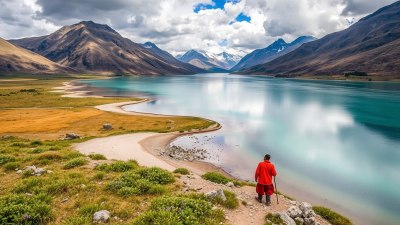Sustainable Travel in the World’s Most Remote Regions
Explore the principles and practices of sustainable travel in remote areas worldwide.

Sustainable travel has emerged as a crucial aspect of modern tourism, especially as travelers increasingly seek experiences off the beaten path. The allure of remote regions lies in their pristine natural beauty and cultural richness. However, these areas are often vulnerable to the pressures of tourism. In this article, we will explore the concept of sustainable travel specifically in the world’s most remote regions, discussing its importance, principles, and practical applications for both travelers and local communities.
The Importance of Sustainable Travel
Sustainable travel encompasses methods and practices that aim to minimize the negative impacts of tourism on the environment, culture, and economy of the destinations visited. In remote regions, where ecosystems can be fragile and communities often rely heavily on natural resources, the stakes are particularly high. Responsible travelers should be aware that their actions can have lasting effects.
Many communities in remote areas depend on tourism for economic livelihood but may struggle to balance this with maintaining their unique cultural heritages and natural environments. As a result, sustainable travel can play a critical role in facilitating healthy tourism development that benefits local populations while preserving their way of life.
Principles of Sustainable Travel
Embracing sustainable travel in remote regions involves several key principles. The first is conservation, which refers to the responsible management of natural and cultural resources to prevent degradation. This can include protecting wildlife habitats, conserving water, and promoting the sustainable use of local resources.
Second, sustainable travel emphasizes community involvement. Engaging local populations in tourism planning and decision-making helps ensure that their needs and perspectives are considered. This supports local economies and fosters a sense of ownership and pride among residents.
Third, sustainable travel encourages minimal environmental impact. Travelers can take steps to reduce their footprint, such as choosing eco-friendly accommodations, limiting waste, and using public or low-impact transportation methods.
Finally, cultural respect is paramount. Travelers should educate themselves about local customs and traditions, practice responsible behavior, and demonstrate respect toward the cultures they encounter. This fosters mutual understanding and appreciation, enriching the travel experience.
Challenges of Travel in Remote Regions
Traveling to remote regions presents unique challenges. Accessibility can be difficult, as many of these areas lack infrastructure, such as roads and reliable transportation. This can deter potential travelers while also making it difficult for local goods and services to reach remote communities.
Additionally, the lack of resources can make it challenging to implement sustainable practices effectively. For instance, waste management systems may be limited, requiring travelers to take additional steps to minimize their impact.
Limited awareness of sustainable practices among travelers can also pose a challenge. Not all tourists understand the importance of minimizing their ecological and cultural footprint, making education and outreach crucial components of sustainable travel efforts.
Case Studies of Sustainable Travel in Remote Regions
Several remote regions worldwide have embraced sustainable travel, demonstrating effective practices. In Costa Rica, a country known for its rich biodiversity, eco-tourism has flourished. The government has emphasized conservation efforts through various initiatives, such as national parks and protected areas. Local communities have adopted sustainable agriculture and eco-friendly lodging, showcasing the benefits of protecting the environment while providing economic opportunities.
Another noteworthy example is Bhutan, a tiny Himalayan kingdom that measures its prosperity based on Gross National Happiness rather than GDP. Bhutan’s tourism policy focuses on high-value, low-impact tourism, implemented through a daily tariff system that regulates the number of visitors. This strategy ensures that tourism revenue supports local development, conservation, and cultural preservation.
In Alaska, indigenous communities are leading the way in sustainable travel practices. They offer guided tours that highlight traditional knowledge and practices while promoting cultural understanding. These experiences benefit local economies and encourage tourism that respects and honors their heritage.
Practical Tips for Sustainable Travel in Remote Regions
Travelers looking to explore remote regions can adopt several practices to ensure that their trips are sustainable. First, research the destination to understand its environmental and cultural context. Learn about local customs, laws, and conservation efforts to foster respect for the area and its residents.
Choose eco-friendly accommodations that implement sustainable practices, such as waste reduction, energy efficiency, and local sourcing of food. Supporting local businesses, artisans, and guides strengthens the economy and provides more authentic experiences.
Opt for low-impact transportation methods, such as walking, biking, or public transit, when possible. This reduces carbon emissions and allows for deeper engagement with the landscape and communities. When traveling to remote areas, consider traveling during off-peak seasons to minimize overcrowding and support the local economy more evenly throughout the year.
Practice Leave No Trace principles, which encourage travelers to leave the environment as they found it. This includes packing out trash, staying on designated trails, and being mindful of wildlife interactions. Through these actions, travelers can help preserve the natural beauty and integrity of remote regions for future visitors.
Engaging with Local Communities
Engagement with local communities can enhance travelers' experiences and foster sustainable tourism. Seek opportunities to participate in local cultural events, workshops, or volunteer programs. Such interactions provide deeper insights into the culture and promote cross-cultural understanding.
Travelers may also consider making donations or supporting local conservation projects to further contribute to the preservation of the environment and culture of remote areas. By doing so, they can leave a positive impact and ensure that the benefits of tourism reach those who need them most.
The Future of Sustainable Travel in Remote Regions
The future of sustainable travel in the world's most remote regions depends on the collective efforts of travelers, tour operators, and local communities. As awareness of the environmental and cultural vulnerabilities of these areas grows, sustainable practices will likely become more prevalent. Technologies that promote sustainable transportation and energy use will assist in reducing the ecological footprint of travel.
Additionally, increased collaboration among stakeholders can lead to improved strategies for sustainable tourism development. By involving local communities in tourism planning and management, stakeholders can address challenges and create solutions tailored to specific contexts. Building networks of sustainable tourism operators can facilitate knowledge sharing and best practices, ultimately enhancing the impact of sustainable travel.
Moreover, with changing consumer preferences, travelers increasingly seek experiences that allow them to give back to destinations. This shift signifies that sustainable travel is not just a trend but is becoming a fundamental principle that travelers prioritize when choosing remote destinations.
In conclusion, sustainable travel in the world’s most remote regions is essential for the preservation of natural environments and the welfare of local communities. By adopting responsible travel practices, engaging with local cultures, and supporting sustainability initiatives, travelers can ensure that their journeys positively impact both the places they visit and the people who live there. Embracing these principles today will help safeguard the beauty and integrity of remote regions for generations to come.











